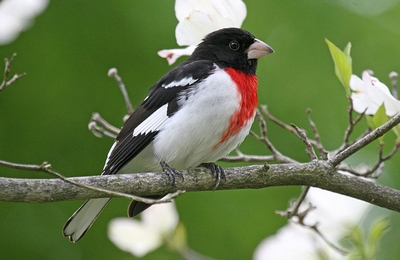Birds in their little nests agree.
A Latin proverb

Rose-breasted Grosbeak: Have you seen this bird?
Rose-breasted Grosbeak
The Rose-breasted Grosbeak, Pheucticus ludovicianus, is a large seed-eating bird in the cardinal family.
The Rose-breasted Grosbeak’s breeding habitat is open deciduous woods across most of Canada and the eastern United States. Northern birds migrate to southern Mexico south through Central America to Peru and Venezuela in winter.
Identification Tips:
• Length: 7.25 inches
• Large, conical, pale bill
Adult male:
• Rosy-red, triangular breast patch
• Black head and upperparts
• White underparts
• White patches in wing
• White spots in black tail
• Rosy-red wing linings
• Male in Fall and Winter is duller, browner
• Immature male similar to adult male in Fall and Winter but duller
Adult female:
• Black and white crown stripes
• White underparts with extensive streaking
• Dark gray upperparts
• Yellow to yellowish-orange wing linings
• Immature female similar to adult female
• Juvenile has buffy breast
Similar species:
Female-plumaged Black-headed Grosbeak is very similar to female-plumaged Rose-breasted Grosbeak but has buffier breast and has streaking confined to the sides.
The Rose-breasted Grosbeak forages in shrubs or trees for insects, seeds and berries, also catching insects in flight. In the winter quarters, they can be attracted into parks, gardens, and possibly even to bird feeders by fruit like Trophis racemosa.
Misguided fire prevention policies have created habitat on the Great Plains, thereby allowing the Rose-breasted Grosbeak to extend its range westwards.
Birds in their little nests agree.
A Latin proverb
Bird Quotation Popularity Poll
(4 answers max)
 Loading ...
Loading ...
Add any comments below and/or indicate if you spotted this bird.
Birds in their little nests agree.
Bird Quote Notice
Please submit bird sayings, bird quotes, bird poems, or your own bird quote. Enter the bird quotation for others to enjoy by filling out the Submit form on the menu.









